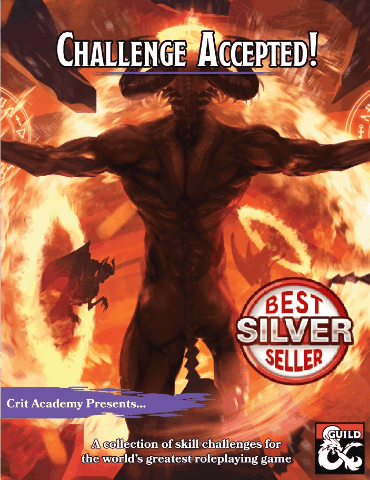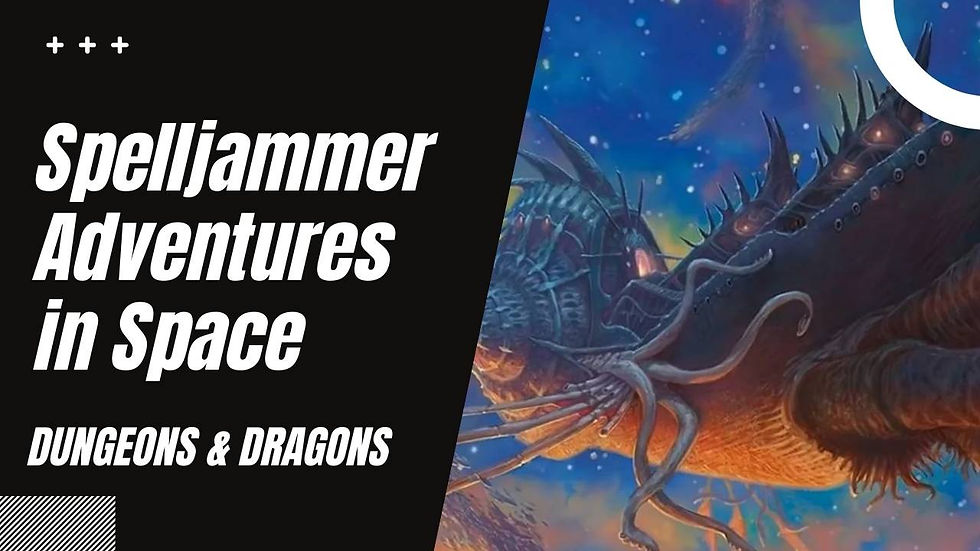Top 5 Questions to Ask to Make Good Rulings in Dungeons & Dragons
- Justin Handlin

- Aug 1, 2021
- 6 min read
Top 5 Questions to Ask to Make Good Rulings in D&D
Do you ever second guess a ruling in your Dungeons & Dragons? Do you want help ensuring you make the best ruling possible? If so, then check out these Top 5 Questions to Ask to Make Good Rulings in D&D.
As Dungeon Masters, we often find ourselves having to make rulings on the fly. Either because it isn’t covered in the rules, we don’t fully know all the rules, or we just don’t have a way to look up other answers. Though, let's be honest, even looking up rules really slows down the game, and interrupts the flow. Using these questions, you ensure that you always make the best ruling possible, with, or without the rulebooks.
Does it make sense?
Is it fair?
How much does it really matter?
Does it radically change the story or campaign?
Does it add to the fun of the group?
Character Concept: Grayson “Silver Tongue” Nash
Description:
A man with thick toned arms and a paunchy gut. He tends to wear heavy leather. Coupled with his rolled up shirt sleeves this gives him a very relaxed look. His black hair is cut short. He is missing an eye and his face is severely scarred. His one remaining eye shines amber.
Personality:
He trusts no one. He is not readily capable of forgiveness and his ire never leaves him. He is an exceptional liar with an equally exceptional compulsion to do so. Known for his sharp tongue, temper and sharper sword skills, Nash was one of the few pirate captains to build and maintain his ship from the remains of those he pilfers.
History:
His piracy career was cut short by a strange mutiny, however, and he was abandoned to the magistrate who had been hunting him since he'd raided a ship carrying valuable artifacts.
Motivation: Since the mutiny against him, he has been meticulously hunting and killing the mutineers who betrayed him and stole his vessel.
Monster Variant: Zirundr
Origin Statblock: Otyugh
Lost Features: Limited telepathy, bite, tentacles
New Features:
Increase strengths core to 20 and intelligence to 10.
Titanic Strength: The zirundr’s movement is not reduced when grappling two or less creatures.
Four-Arm Assault: Melee Weapon Attack: +8 to hit, reach 5ft., one target. Hit: 14 (2d8 +5) bludgeoning damage. If the target is a creature, it must succeed on a DC 15 Strength saving throw or be knocked prone.
Slam: Melee Weapon Attack: +8 to hit, reach 5 feet., one target. Hit: 14 (2d8 + 5) bludgeoning damage. If the target is Medium or smaller, it is grappled (escape DC 15) and restrained until the grapple ends. The zirundr has four arms, each of which can grapple one target. If the zirundr uses two or more arms to grapple a target, the target has Disadvantage on the check to break free.
Body Slam. The zirundr slams creatures grappled by it into each other or a solid surface. Each creature must succeed on a DC 15 Constitution saving throw or take 12 (2d6 +5) bludgeoning damage and be stunned until the end of the zirundr’s next turn. On a successful save, the target takes half the bludgeoning damage and isn’t stunned.
Staggering Rock. Ranged Weapon Attack: +8 to hit, range 60/240 ft., one target. Hit: 21 (3d10 + 5) bludgeoning damage and it’s speed becomes 0 until the end of their next turn.
Reaction:
When a creature successfully breaks the zirundr’s grapple, it can use its reaction to attempt to grapple the creature again.
Encounter: Wandering Travellers
The characters encounter a draft horse pulling a battered old wagon. Accompanying the wagon are ld6 - 1 people (use the commoner stat block unless otherwise noted below). If the die result indicates that no commoners are present, that means the drivers are either missing or dead, leaving the horse and wagon unattended.
If one or more people are present, assume that they are guiding the wagon toward the nearest settlement. The encounter might be one of the following:
Friendly furriers transporting 3d6 bundles of animal pelts worth 100 gp per bundle
Friendly peddlers transporting 4d6 ten-gallon kegs of fine bourbon toe ale worth 8 gp each
Friendly, minstrels looking for the next town tavern, inn or taproom to perform.
Hostile bandit berserkers posing as friendly traders, transporting a stolen wagon laden with foodstuffs to their camp
A family fleeing their homestead in the wake of a monstrous creatures (a hive of ankhegs) attacking and setting up a nest in their village; the wagon contains their food and their mundane belongings
A friendly merchant transporting 2d6 pigs worth 5 gp each; any other persons present are adventurer’s hired to ward off bandits and other threats
Hostile mercenary veterans transporting 1d4 crates weapons and armor to their allies in a nearby settlement
Magic Item: Tome of Material Perfection
Wondrous Item, (rare) from Blackmagus
A treatise on material component preparation and improvement by Master Wizard Robert Kross. This work is most interesting to those into the science of how material components interact with spells and how to get more out of their items surrounding each spell.
The reader must know the following languages: common, draconic, infernal.
This course requires 12 hours of study.
A creature who is studying the material must succeed on a DC 19 Intelligence check during a long rest. After a successful study the caster will be able to modify and improve material components enough to make a difference with arcane effects.
Through much trial and error, Master Kross documented many spell changes when the components for spells were treated before use. Unfortunately he never was able to stop consumable components from being consumed, merely delayed for a time.
First refinement is compression. Through the use of a runic cylinder. The amount of the component to be compressed equal to (spell level + 1 in gold), is placed in the container and activated. Once complete , the device produces 1 usable compressed item. The resulting compressed component will have the following effects added to a spell. Non damaging effects are increased by half. For example, the light spell, instead of 20ft of light it would be 30 ft. Damaging spells die increase by 1, for example d4 to d6.
For 100% refinement, cost is doubled and non damage effects are doubled, damaging spells still only get the single increase in damage die, but get to reroll all 1 and 2. Taking 10 minutes per level to complete.
Second refinement is encasing. Through the use of a runic crucible, metal may be melted down to glaze the item. This magically charged metal changes color (casters choice). Once an item is encased and is used, the spell's duration is extended by half or doubled. For half the cost is 5 gp for spell levels 3 and under and 10 gp for spell levels 4-6. 15 gp for spell levels 7-9, but they can only be extended by half. Takes 15 minutes per spell level to complete.
Third refinement is fortification. Through the use of a platinum tipped etcher with a hollow tube that is ‘loaded’ with the dust of precious gems. As it moves on the surface of the component, that costs 1 gp or more, it marks the item with the gem dust. The runes embedded reinforce for longevity. The amount of dust used costs 50% of the base item, and also covers the item the same amount. That item can be used for 2 castings before it is consumed. By paying double the base item cost and covering it completely, the item can be used 4 times before it is consumed. Takes 30 g per spell level to complete.
Dungeon Master Tip: Fantastic Settlements
In the magical world of the D&D game, most settlements follow a set of patterns. But fantastic exceptions abound, cities where magic or monsters play a significant role in government, defense, commerce, or organizations. You can use these variations to inject a fantastic flavor into the settlements your characters visit.
Rather than a noble lord who’s nothing more than a titled aristocrat, a town or city might be ruled by a wizard, perhaps a retired adventurer, whose magical power makes a personal retinue of soldiers unnecessary.
What happens when a dragon decides to take over a city? Or a mind flayer secretly controls the baron, steering the city toward its own mysterious purposes? What if the ruler is a lich or vampire who installs undead in positions of power?
As those examples suggest, not every settlement in the D&D world is a point of light in the darkness, some are part of the darkness.
Player Tip: Don’t be a Dick Building Character
Your choice of race for your player character establishes many of the fundamental traits that define your roleplaying experience. Specific values, perspectives, and motivations are associated with each race in the campaign setting. Although your selection of geographical raising or profession background informs your character’s outlook, race is often a primary contributing factor. Not only for your, but for the way the characters and NPCs perceive you. As a player, spend time learning a bit about your race's place in the world. Lean on those cultural and spiritual values to help flesh out your character.
Make sure to subscribe to our show at www.critacademy.com, and Youtube so we can help you on your future adventures as well as a chance to win cool prizes each and every week. Make sure to check out our fellowship members as well. Or support us on Patreon and get weekly Dungeons and Dragons loot!
*Crit Academy is an Affiliate of Amazon, DMsguild and DriveThruRPG*















Comments